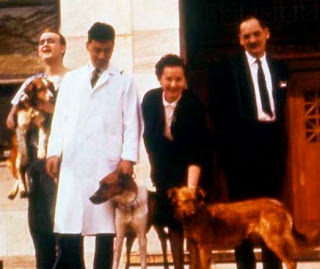Years of experimentation finally pay off
 |
|
Roy Calne (white coat) with dogs Tweedledee,
Titus and Lollipop, recipient of the first successful long-term
organ transplant, using azathioprine (Copyright of and with
permission from Sir Roy Calne – link to source) |
Transplantation only began to be a real prospect for patients with chronic renal failure in the mid 1960s, after many, many unsuccessful attempts. Success with several pairs of identical twins (when one had kidney failure and the other didn’t) showed that the technical problems, largely worked out in dogs, had been solved. However the problems of rejection had not. (see First transplants post)
Frank Burnet and Peter Medawar won the 1960 Nobel Prize in Medicine for work that defined rejection and immune tolerance. Medawar worked in the Glasgow Burns Unit on skin grafting during the Second World War, and subsequently with Burnet. He came to believe that the problem of rejection could not be solved. Certainly in the early 1960s there was no way of suppressing rejection without usually killing the patient, as many attempts showed. Whole body irradiation was transiently adopted, then there were experiments with various drugs including corticosteroids, cyclophosphamide and thiopurine, sometimes with brief or isolated successes.
As long-term dialysis was scarcely available or even thought of before this time, the high risks of these early transplants were felt to be justified. Several of the UK’s early dialysis units were established by transplant surgeons to support the patient temporarily. After work by Roy Calne in dogs, an analogue of thiopurine, azathioprine, was first used in human transplantion 1962, in Boston and then in Edinburgh, both successfully. However toxicity was still high and further deaths followed.
As experience with these new drugs developed, lower doses of azathioprine were used in combination with steroids (prednisolone or prednisone). By 1965, 1 year survival rates of cadaver grafts were over 60%, with live related grafts higher still. Dr Molly McGeown in Belfast pioneered a highly successful regimen using lower doses of prednisolone, 20mg per day from day 1, and this was taken up widely in other centres during the 1970s. However the Belfast results remained strikingly good, much better than other centres, showing that it wasn’t just what you used, but how you did it – the elusive ‘centre effect’. The Belfast results reported in 1977 showed 82% two-year survival from 102 transplants in 93 patients 1958-77; a level of success that many units struggled to match until several years after the next major anti-rejection milestone, the introduction of Cyclosporin. This was first approved for use (and it took some getting used to) in 1983 after trials led by Roy Calne in Cambridge in 1978-9.
Four other developments were important before Cyclosporin came into general use.
|
A vial of anti-lymphocyte
globulin made in horses
in Edinburgh in 1972
|
A new anti-rejection tool introduced in the 1960s was anti-lymphocyte serum, antibodies raised in rabbits or horses to kill human lymphocytes, which had been developed during the 1950s and 60s.
‘Cross-matching’ using white blood cells to prevent hyperacute rejection was described by Terasaki in 1965, and the basis of tissue typing and its impact on graft survival was mapped out from then. The benefits of tissue type matching with modern drugs are smaller but still detectable.
In 1974 Terasaki also reported that patients who had received blood transfusions were less likely to reject their transplants. There was understandable reluctance to introduce deliberate transfusion policies in the light of previous experience on dialysis units with hepatitis, and the risk of sensitisation to tissue type antigens, but in the azathioprine/prednisolone era the effect was quite substantial so it was adopted by most units. With modern drugs it is no longer a powerful effect and has been abandoned again.
The fourth and final developments were medicolegal, increasingly allowing the use of cadaver donors, which formed the great majority of transplants in this era.
It is striking that the core tools of transplantation in the 1960s, azathioprine and steroids and anti-lympocyte antibodies, and the basic surgical technique, are still in use today. The major pharmaceutical modification has been the addition of the calcineurin inhibitor Cyclosporin and later Tacrolimus. Azathioprine has been partially supplanted by an equivalent drug Mycophenolate. More specific and targeted antibodies of various kinds are also in use, though many of these have yet to find a firm place. The ambition of inducing tolerance so that the patient does not require long term immunosuppression is closer, but has still not been achieved for human transplantation.
In 1988 McGeown was reporting that Belfast’s 10 year graft survival was 55%, and patient survival was 67%. Death with a functioning graft was becoming an important issue, with most deaths occurring not from kidney disease, but from cardiovascular causes. With most units now using Cyclosporin and beginning to aspire to this sort of long-term success rate, the possibility of moving on to think about long-term problems marked the beginning of the modern transplant era.
Further info
Sir Peter Medawar’s Nobel Prize lecture (Nobel Prize website)
History of transplantation (with a UK bias) from the BTS
Roy Calne. Recollections from the Laboratory to the Clinic. In: Terasaki PI (ed) History of Transplantation: thirty-five recollections. UCLA Press, 1991
Starzl TE. The development of clinical renal transplantation. Am J Kid Dis 1009 6:548-56
Murray JE. Human organ transplantation: background and consequences (from Nobel prize lecture 1990). Science 1992 256:1411-15
Transplantation in Edinburgh from www.edren.org
Dialysis and transplantation in Belfast by Mollie McGeown; and a 1998 interview with Dr McGeown (ISN videolegacy project)
Transplantation in Edinburgh from www.edren.org
Dialysis and transplantation in Belfast by Mollie McGeown; and a 1998 interview with Dr McGeown (ISN videolegacy project)
An article based on this post will appear in the Journal of Renal Nursing in August 2011.